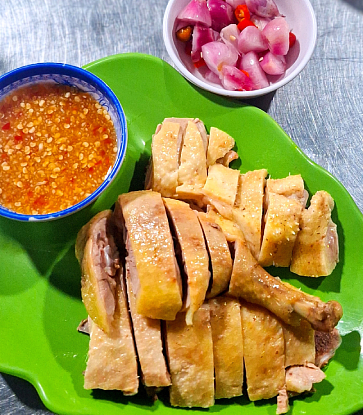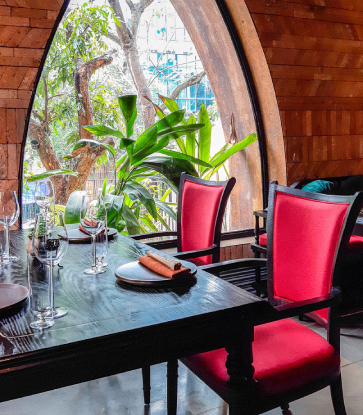From aromatic pho simmering with rich flavours to crispy banh mi bursting with savoury fillings, Vietnam's culinary treasures are renowned worldwide.
Join us as we unveil the secrets to embracing the true essence of some Vietnamese delicacies.

Phở (Pho)
Pho, undoubtedly the most renowned Vietnamese dish worldwide, offers a delightful medley of flavours. A steaming bowl presents a harmonious combination of pho (rice noodles), tender meat (beef or chicken), aromatic herbs, and a fragrant broth. To truly appreciate its essence, first savour the broth before adding any vegetables or condiments.In the northern regions of Vietnam, a customary practice is to enhance beef pho with a splash of vinegar, while lemon is favoured for chicken pho. In the southern parts of the country, pho broth is often infused with a touch of sugar, rendering it slightly sweeter. Additionally, the southern variant incorporates a variety of toppings, including beef balls, tripes, tendon, and even oxtail. Southerners further enrich their pho bowls by adding fresh vegetables and herbs such as basil and coriander for added aroma.

Bánh Cuốn (Banh Cuon, or steamed rice rolls)
Banh cuon is made from rice flour, thinly coated on a cloth and steamed in a large pot of water for a few minutes. When the wrap is cooked, it will be rolled with fillings, such as pork, shrimp, wood-ear mushrooms, shiitake mushrooms, and chopped green onions.This steamed rice wrap often accompanied by a medley of trimmings: a few slices of Vietnamese pork bologna, roasted cinnamon pork, fermented cucumber and bean sprouts, and, of course, a ramekin of mild fish sauce.

Bún Chả Hà Nội (Bun cha Hanoi, or grilled pork with rice vermicelli)
Originating in Hanoi, bun cha is a dish composed of three key components. First, a bowl of grilled sliced pork belly and/or succulent minced pork patties and a mild dipping sauce with pickled vegetables. Then, a plate of delicate rice vermicelli. And, finally, a basket of fresh herbs, including perilla leaves, coriander, and lettuce.
To fully appreciate this culinary masterpiece, begin by delicately grasping some vermicelli (with chopsticks for preference) and submerging that into the enticing bowl of pork. Add some raw vegetables, and enjoy the stunning medley of savoury, sour, spicy, and sweet.
The sliced pork and pork patties are meticulously marinated and grilled over hot charcoal until they attain a captivating golden-brown hue. The dipping sauce, concocted from a blend of fish sauce, sugar, water, and vinegar, strikes a harmonious balance between sweetness, tanginess, and umami, further accentuating the overall taste experience.

Bánh Mì (Banh Mi)
In Vietnam, banh mi is a ubiquitous street food, found in every city and on any street. This hearty treat boasts a multitude of regional variations, each showcasing unique culinary characteristics. The key to crafting a perfect banh mi lies in the meticulous preparation: the bread must be toasted to a crisp, golden hue, then delicately opened, spread with pate, filled with an array of meats, and topped with a tantalising sauce.One quintessential rendition of banh mi in Hanoi features a delicate layer of butter, liver pate, meat floss, delectable ham, and a few slices of pork bologna. To balance the meaty flavours, fresh coriander, cucumber, and ground chilli sauce are added, elevating both the taste and nutritional value.
In the southern regions of Vietnam, banh mi takes on an even more veggie-centric approach. Slices of cucumber, white radish, pickled carrots, onions, cilantro, and chilli are added to create a burst of freshness and crunch. The fillings come in a wider range of options, including shumai, roasted pork, shredded pork skin, fish bologna, and hearty offal stew, catering to diverse tastes and preferences.

Bánh Xèo (Banh Xeo, or crispy Vietnamese crêpe)
Bánh xeo, also known as Vietnamese crêpe, is a delectable fried pancake created from a mixture of rice flour, water, and turmeric powder. The name itself is derived from the sizzling sound produced when the thin layer of rice batter is poured onto a hot skillet. While the traditional filling typically comprises pork or shrimp, variations nowadays include an array of options, such as mushrooms, duck, chicken, and seafood.There are two distinct types of banh xeo that hold regional prominence.
In the Central region, small banh xeo is particularly popular. The crust of these pancakes strikes a delicate balance, neither too thick nor too thin. The result is soft and slightly pliable. It is often served in small bowls or plates alongside fresh vegetables and a dipping sauce, allowing diners to customise their bites with different combinations.
In the South, banh xeo takes on a larger form, resembling a sizeable plate. The crust boasts a satisfying crispness, with a slightly chewy texture in the centre, subtly infused with the light flavours of coconut milk. The filling typically features a combination of pork belly, shrimp, and green beans. This banh xeo is cut into smaller pieces, wrapped in lettuce along with various herbs, and sometimes enveloped in rice paper. The final step involves dipping the rolls into a delightful sweet and sour fish sauce.

Bánh Canh Cua (Crab tapioca noodles)
Banh canh cua are luscious Vietnamese noodles known for their thickness, crafted from tapioca flour or a combination of rice and tapioca flour. Banh canh cua specifically refers to banh canh noodles served in a sumptuous and velvety crab soup, often enhanced with the delightful addition of quail eggs.To the people of Southern Vietnam, banh canh cua holds a special place as an all-time favourite comfort food, especially during rainy or chilly days. The chewy texture of the noodles, the sweet and velvety essence of the broth, and the captivating aroma of the crab meat all intertwine harmoniously, creating an irresistible and enticing culinary experience.

Ốc (Oc, or snails)
At a typical Vietnamese snail vendor, you'll find offerings that go beyond snails. Clams, scallops, mussels, shrimps, and various lesser-known shellfish await, providing a delightful surprise for your taste buds.Boiling snails with lemongrass is the easiest way to prepare this delicacy. A toothpick is used to poke the snails out to dunk in a spicy dipping sauce. This sauce holds the key to the mesmerising taste, combining fish sauce with minced ginger, lemongrass, garlic, and chilli, creating a wonderful blend of flavours that elevates the snail-eating experience.
Nowadays, snail dishes can be more sophisticated and elaborate, introducing additional layers of flavour. Adventurous options include snails fried with salted egg sauce, roasted with salt, grilled with onions, stir-fried with lemongrass and chilli, grilled with green pepper, or stir-fried with coconut. These inventive variations offer a unique and creamy twist to the traditional version, enhancing the overall enjoyment.
So, which dish would you like to try first?





















